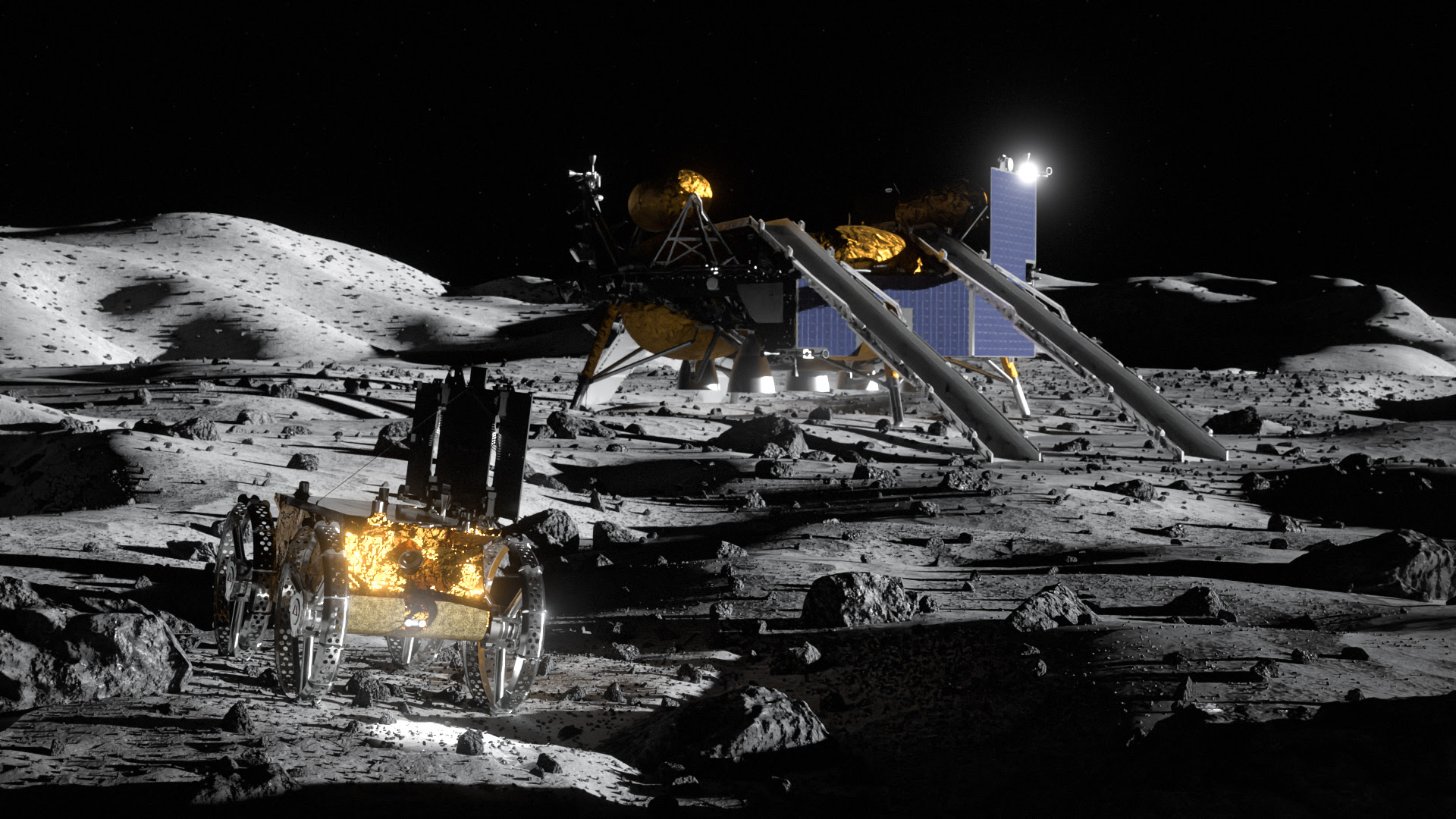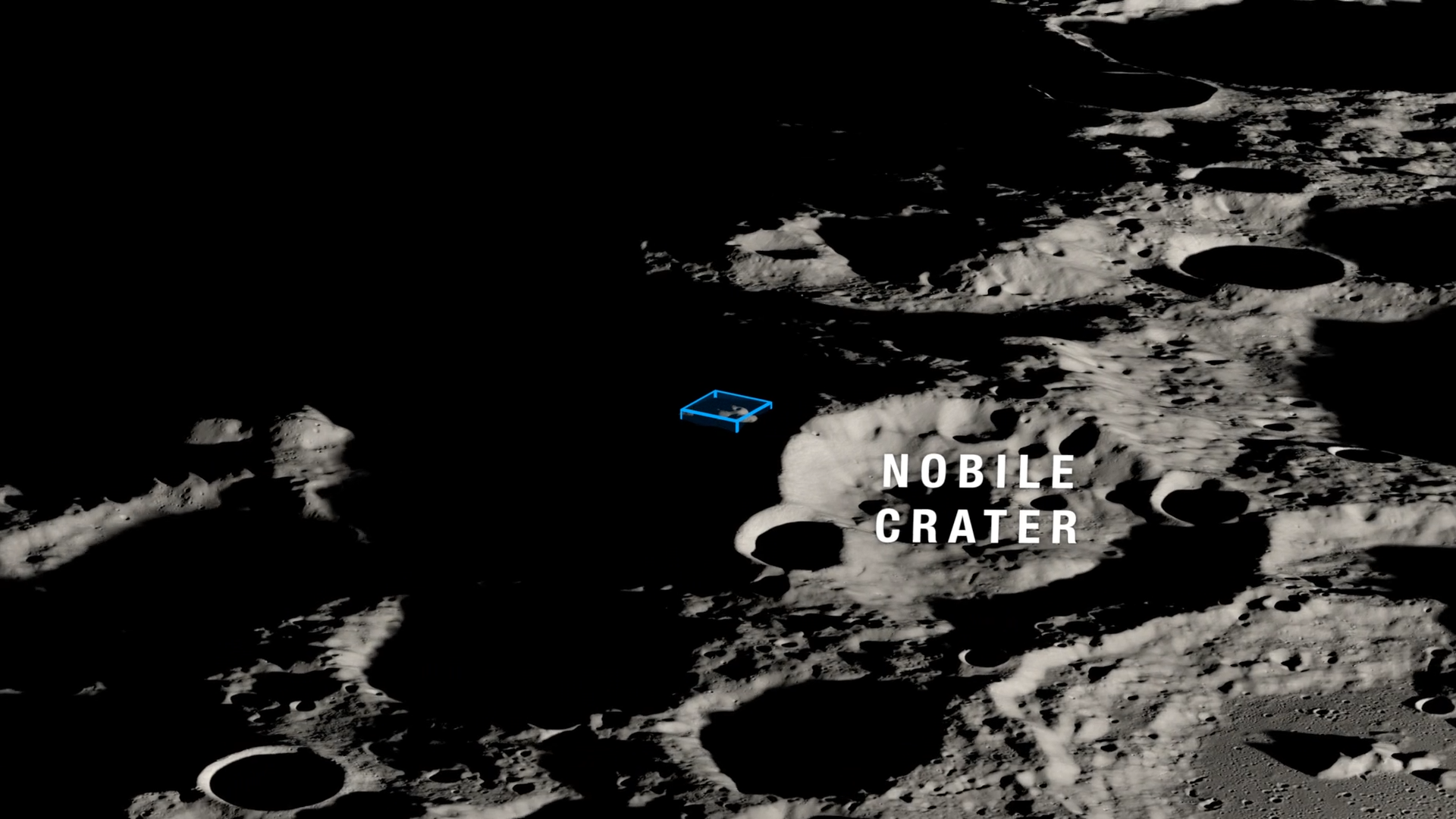
COLORADO SPRINGS, Colo. — Astrobotic's next moon mission will send not one but two rovers to Earth's nearest neighbor.
The Pittsburgh-based company plans to launch the first-ever mission of its Griffin moon lander atop a SpaceX Falcon Heavy rocket later this year. Griffin's main job is to deliver NASA's ice-hunting VIPER rover to the lunar south polar region, but we learned on Monday (April 8) that the lander will tote another, smaller rover as well.
Also hitching a ride on the Griffin-1 mission is Astrobotic's CubeRover, a modular little machine designed to make moon exploration accessible to a variety of customers. It will be operated using Spacefarer, a software platform developed by the Canadian company Mission Control.
"What an exciting time in space exploration, as commercial companies are at the very beginning of creating a new market economy on the moon," Lisa Campbell, president of the Canadian Space Agency (CSA), said on Monday during a press conference held here at the 39th Space Symposium.
"This mission promises to be groundbreaking, a demonstration of commercial space technology," she added. "But quite frankly, I think it's just going to grow from here."
Related: Missions to the moon: Past, present and future
Griffin will touch down on Mons Mouton, a flat-topped mountain that's about the size of Delaware.
Get the Space.com Newsletter
Breaking space news, the latest updates on rocket launches, skywatching events and more!
The stationary lander's primary payload is VIPER (Volatiles Investigating Polar Exploration Rover); Astrobotic got a $199.5 million contract from NASA's Commercial Lunar Payload Services (CLPS) program in June 2020 to get VIPER safely down on the gray dirt. (The contract is end-to-end, meaning Astrobotic was responsible for securing the launch vehicle as well.)
Mons Mouton is near the lunar south pole. This region thought to be rich in water ice, which explains why NASA plans to build a base in the area via its Artemis program. But it's unclear how much ice is actually present near the south pole, and how accessible it is — and that's where VIPER comes in.
The 1,000-pound (450 kilograms) rover, which is as big as a golf cart, will spend about 100 Earth days mapping out the distribution and concentration of water ice in the Mons Mouton area.
"NASA will use the data the rover collects to show where the moon's ice is most likely to be found and easiest to access, making VIPER the first-ever resource-mapping mission on another celestial body," NASA officials wrote in a mission description. "The first resource maps of the moon will mark a critical step forward for NASA's Artemis missions to establish a long-term presence on the surface of the moon."
The shoebox-sized CubeRover, meanwhile, will embark upon a demonstration mission that's being supported by CSA's Lunar Exploration Accelerator Program. The little rover will deploy after VIPER, belaying from Griffin down to the lunar dirt on cables.
CubeRover will operate on the suface for one lunar day, which is equal to about two Earth weeks. It will perform communications trials with Griffin, drive in the lander's shadow to test its ability to handle thermal extremes, and showcase the abilities of the Spacefarer operating platform on the moon for the first time, if all goes according to plan.
And this first mission will be just the beginning for CubeRover, according to Astrobotic. The wheeled robot can be scaled up to accommodate larger payloads; future versions could haul science instruments and other gear around the moon and remain operational for a year or more, according to Mike Provenzano, vice president of advanced development programs at Astrobotic.
"We're really excited by the opportunities that this is going to enable for the [lunar business] ecosystem," Provenzano said during Monday's press briefing.

Griffin-1 won't be Astrobotic's first moon mission. The company's smaller Peregrine moon lander launched Jan. 8 on the debut liftoff of United Launch Alliance's new Vulcan Centaur rocket.
The launch went well, but Peregrine suffered a problem with its propulsion system shortly after deploying from the Vulcan Centaur's upper stage. That issue doomed the lander's planned moon mission, which was also funded by CLPS; Astrobotic ended up steering Peregrine to a controlled destruction in Earth's atmosphere on Jan. 18.
Twenty payloads went down with Peregrine, including Iris, a CubeRover-like robot developed by students at Carnegie Mellon University in Pittsburgh.
Astrobotic has revealed a few other payloads that will fly on Griffin-1 in addition to VIPER and CubeRover. Also going up are the European Space Agency's LandCam-X landing-camera system, for example, and a NASA laser retroflector. More payloads could be announced in the coming weeks and months, company representatives said on Monday.
Join our Space Forums to keep talking space on the latest missions, night sky and more! And if you have a news tip, correction or comment, let us know at: community@space.com.

Michael Wall is a Senior Space Writer with Space.com and joined the team in 2010. He primarily covers exoplanets, spaceflight and military space, but has been known to dabble in the space art beat. His book about the search for alien life, "Out There," was published on Nov. 13, 2018. Before becoming a science writer, Michael worked as a herpetologist and wildlife biologist. He has a Ph.D. in evolutionary biology from the University of Sydney, Australia, a bachelor's degree from the University of Arizona, and a graduate certificate in science writing from the University of California, Santa Cruz. To find out what his latest project is, you can follow Michael on Twitter.
